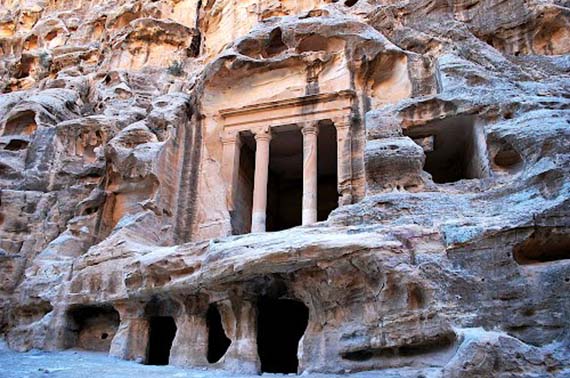Al-Beida
After or before your visit to Petra, plan a short trip to the nearby Al-Beida. This area is located at only a ten-minute drive north of Petra and hosts two important highlights of Petra Archaeological Park: The Beida Neolithic Village and Little Petra.
The Neolithic Village in Al-Beida – One of the oldest sights in the Middle East and Human History
The Al-Beida Neolithic village is an exceptional archaeological site containing the remains of Pre-Pottery Neolithic human settlements. It has great historical and archaeological importance as it is considered one of the first settled areas in human history. The rest of the ancient Neolithic dwellings suggest that the site was occupied from 7200BC to 6500BC, first by nomadic tribes that camped the area seasonally, and later by permanent settlers living of farming and herding. The site provides crucial evidence of the first transitions from semi-settled nomads to settled villagers and the start of an agrarian economy.
Little Petra – The magic of the Nabatean ruins in a relaxing atmosphere
Little Petra site comprises a marvellous cluster of Nabatean architectures similar to those found in Petra. The complex is believed to have been the first Nabatean settlement in Wadi Musa. The Nabateans established themselves along the Sig al-Barid, in Arabic the “Cold Canyon”, close to the Neolithic settlement. They carved their settlement into the sandstone cliffs and introduced sophisticated engineering solutions to bring water into the area. After the construction of their larger city at Petra, Al-Beida became an important suburb of Petra serving as an agricultural centre and point of arrival and departure of caravans that traded along the ancient Silk Road connecting Petra with the East and the West. There is also evidence that the site was the centre of many religious activities and celebrations, including the Feast of Drink, a banquet hosted by the Nabatean king. Along with Petra, Al-Beida remained for centuries unknown to everyone but the local Bedouins. In the late 1950s, the excavations by the British archaeologist Diana Kirkbride brought back to light many structures and monuments of little Petra as well as the Al-Beida Neolithic village. The digging continues to the present as many archaeological treasures are still believed to be hidden under the sand. In 2010, the restoration works uncovered two outstanding wall paintings depicting architectural elements and intertwining vegetation, which suggests that Petra and Little Petra were originally coved in paintings.
Many visitors skip the visit of Little Petra, as this site does not offer as many highlights as Petra. For this reason, Little Petra usually remains uncrowded and calm. The few visitors can enjoy the magic of ancient buildings hidden for centuries in a relaxing atmosphere.
For hiking lovers, there is also the opportunity of walking the Little Petra footpath. This 6-hour long trail goes from Little Petra to Petra passing through the Monastery.
Al-Beida highlights:
- The temple
- The triclinia
- The Painted House
- The cistern

